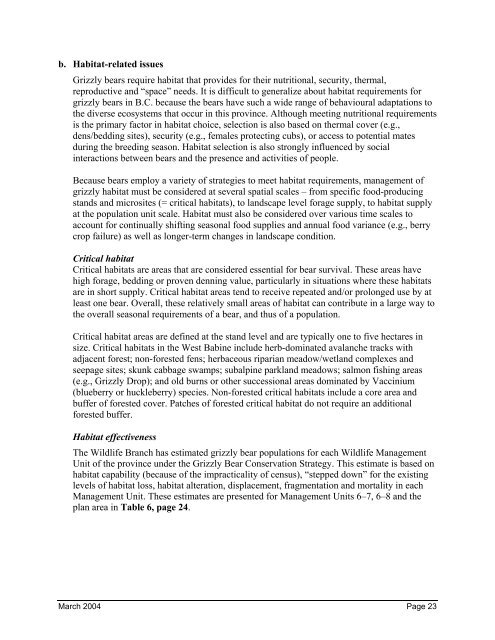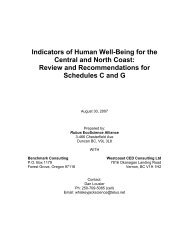West Babine Sustainable Resource Management Plan
West Babine Sustainable Resource Management Plan
West Babine Sustainable Resource Management Plan
You also want an ePaper? Increase the reach of your titles
YUMPU automatically turns print PDFs into web optimized ePapers that Google loves.
. Habitat-related issues<br />
Grizzly bears require habitat that provides for their nutritional, security, thermal,<br />
reproductive and “space” needs. It is difficult to generalize about habitat requirements for<br />
grizzly bears in B.C. because the bears have such a wide range of behavioural adaptations to<br />
the diverse ecosystems that occur in this province. Although meeting nutritional requirements<br />
is the primary factor in habitat choice, selection is also based on thermal cover (e.g.,<br />
dens/bedding sites), security (e.g., females protecting cubs), or access to potential mates<br />
during the breeding season. Habitat selection is also strongly influenced by social<br />
interactions between bears and the presence and activities of people.<br />
Because bears employ a variety of strategies to meet habitat requirements, management of<br />
grizzly habitat must be considered at several spatial scales – from specific food-producing<br />
stands and microsites (= critical habitats), to landscape level forage supply, to habitat supply<br />
at the population unit scale. Habitat must also be considered over various time scales to<br />
account for continually shifting seasonal food supplies and annual food variance (e.g., berry<br />
crop failure) as well as longer-term changes in landscape condition.<br />
Critical habitat<br />
Critical habitats are areas that are considered essential for bear survival. These areas have<br />
high forage, bedding or proven denning value, particularly in situations where these habitats<br />
are in short supply. Critical habitat areas tend to receive repeated and/or prolonged use by at<br />
least one bear. Overall, these relatively small areas of habitat can contribute in a large way to<br />
the overall seasonal requirements of a bear, and thus of a population.<br />
Critical habitat areas are defined at the stand level and are typically one to five hectares in<br />
size. Critical habitats in the <strong>West</strong> <strong>Babine</strong> include herb-dominated avalanche tracks with<br />
adjacent forest; non-forested fens; herbaceous riparian meadow/wetland complexes and<br />
seepage sites; skunk cabbage swamps; subalpine parkland meadows; salmon fishing areas<br />
(e.g., Grizzly Drop); and old burns or other successional areas dominated by Vaccinium<br />
(blueberry or huckleberry) species. Non-forested critical habitats include a core area and<br />
buffer of forested cover. Patches of forested critical habitat do not require an additional<br />
forested buffer.<br />
Habitat effectiveness<br />
The Wildlife Branch has estimated grizzly bear populations for each Wildlife <strong>Management</strong><br />
Unit of the province under the Grizzly Bear Conservation Strategy. This estimate is based on<br />
habitat capability (because of the impracticality of census), “stepped down” for the existing<br />
levels of habitat loss, habitat alteration, displacement, fragmentation and mortality in each<br />
<strong>Management</strong> Unit. These estimates are presented for <strong>Management</strong> Units 6–7, 6–8 and the<br />
plan area in Table 6, page 24.<br />
March 2004 Page 23

















